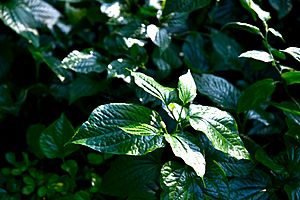Lolot facts for kids
Quick facts for kids Lolot |
|
|---|---|
 |
|
| A Piper sarmentosum plant | |
| Scientific classification | |
| Genus: |
Piper
|
| Species: |
sarmentosum
|
| Synonyms | |
|
List
|
|
Piper sarmentosum is a plant from the Piperaceae family. This family also includes the plant that gives us black pepper. People in many Southeast Asian countries use its leaves in their cooking.
The leaves of Piper sarmentosum are sometimes mistaken for betel leaves. However, they are smaller and do not have the strong taste of betel leaves. Another name for this plant is Piper lolot. It is grown for its leaves, which are popular in Lao and Vietnamese cuisine. In Vietnam, the leaves are often used to wrap meat for grilling, especially a dish called thịt bò nướng lá lốt.
Contents
Different Names for the Plant
This plant does not have one official English name. Sometimes, people call it "wild betel." It has many different names in various languages across Asia.
- In Thai, it is known as chaphlu or cha phlu.
- In Lao, it is called phak i leut or pak eelerd.
- In Malay, people call it pokok kadok.
- In Vietnam, the name lá lốt is used for both Piper lolot and P. sarmentosum.
- It is also known as lolot pepper.
- In Vietnamese, it is usually lá lốt, or sometimes lá lốp in the South.
- In Khmer, it is called japloo or jeeploo.
What the Plant Looks Like
Piper sarmentosum is a plant that grows year after year. It has roots that spread out, and its striped stem can grow up to 40 centimeters (about 16 inches) tall.
Its leaves are thin and shaped like a heart. They are usually 8–10 centimeters (about 3-4 inches) long and 8–11 centimeters (about 3-4 inches) wide. Each leaf has five main veins starting from its base. The top of the leaf has tiny oil glands, and the veins on the underside are slightly fuzzy. The leaf stems are about 2.5–3 centimeters (about 1 inch) long. Small, white flower spikes, 1–2 centimeters long, grow where the leaves meet the stem.
Where the Plant Grows
Piper sarmentosum is found in tropical parts of Southeast Asia. This includes places like Northeast India and South China. It also grows as far away as the Andaman Islands.
Scientists are working to protect this plant. They have taken samples from the Andaman Islands to grow them in special gardens. One such place is the Field Gene Bank in Trivandrum, India. This helps keep the plant safe, especially after events like the tsunami.
How It's Used in Cooking

The leaves of Piper sarmentosum are often sold in bunches. People usually eat them fresh and raw.
- In Bangladeshi cuisine, people chop the leaves and mix them with onions, green chili, and a little mustard oil. This makes a fresh salad that is eaten with plain rice.
- In Thai cuisine, the leaves are used to wrap miang kham. This is a traditional snack where different ingredients are placed inside the leaf. The leaves are also an ingredient in Kaeng khae curry from Northern Thailand. The curry is named after these leaves, which are called khae there.
- In Lao cuisine, the leaves are eaten as part of a salad.
- In Malay cuisine, the leaves are shredded and used in ulam. This is a type of Malay salad.
- In Vietnamese cuisine, the leaves are famous for bò nướng lá lốt. This is a popular dish from Southern Vietnam. Minced beef is seasoned with spices like garlic, onion, and lemongrass. Then, it is wrapped in Piper lolot leaves and grilled. This gives the beef a delicious smoky flavor. The dish is served with rice noodles, fresh herbs, sliced star fruits, pineapples, and a special fermented fish sauce called mắm nêm.
Wrapping meat in leaves started in the Middle East. It came to India with the Persians and then spread to Southeast Asia. Since grape vine leaves don't grow well in tropical places, people in Vietnam started using lolot leaves instead. This plant is native to the Indochinese region. It has also been brought to the United States by immigrants from Laos and Vietnam.
Traditional Uses in Medicine
People in Asia have used Piper sarmentosum leaves in traditional medicines for a long time. Scientists have studied the leaves and found that they contain a special substance called naringenin. This substance is an antioxidant, which helps protect your body's cells.
Parts of the P. sarmentosum fruit have also been studied. They have shown properties that might help fight against tuberculosis and certain types of malaria-causing parasites.
See also
 In Spanish: Lolot para niños
In Spanish: Lolot para niños


